There are still people who believe that the science is ambiguous, or that the scientific community is divided, or even that there is some kind of evil conspiracy on the part of scientists to dupe the public into believing that global warming is happening.
By Ryan McGreal
Published September 08, 2017
Parts of Houston are still underwater after Hurricane Harvey dumped a staggering 1.25 metres of rain on the Texas coast last month. Meanwhile, Hurricane Irma, by some measures the strongest hurricane ever recorded in the Atlantic, is devastating its way across the Caribbean on its way toward Florida.
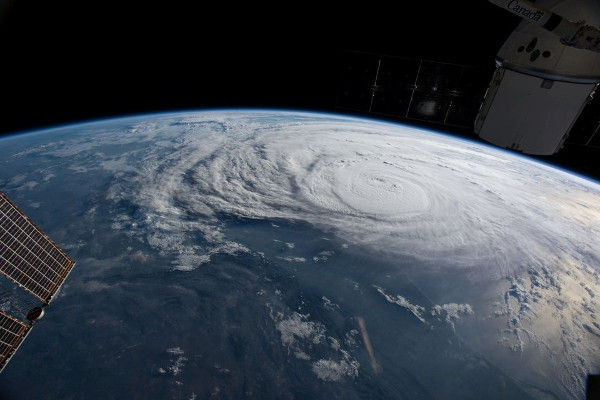
Hurricane Harvey, view from the International Space Station (Image Credit: NASA)
So naturally, the climate change deniers are adamantly insisting that this absolutely no time to talk about global warming or the predicted effects of warmer air and warmer water on the intensity of tropical storms.
Indeed, a great many intelligent and rational people who blandly and unthinkingly accept scientific consensus in other areas of their lives nevertheless continue to doubt the fact that the scientific consensus on global warming is broad, robust, and well-supported by the empirical evidence.
That is, global warming is happening right now in scientific observations that track closely with the climate models used to make the predictions.
The evidence is so clear that 97 percent of all published papers on climate science - an overwhelmingly lopsided unanimity in a field that favours competition and contrarianism - agree with the premise that human activity is changing the climate. (And just for good measure, a recent meta-analysis of the tiny handful of papers that deny this premise found a common set of methodological errors that invalidated their results.)
The fundamental driver of global warming is the greenhouse effect, a very simple concept that scientists were already observing and making valid predictions about in the 19th century. Quite simply, the greenhouse effect is the property of various atmospheric gases to absorb and retain solar energy.
The 19th century mathematician Jean-Baptiste Joseph Fourier (best remembered for the Fourier transform) calculated back in 1824 that the earth was warmer than it should be, given its distance from the sun, and concluded that the atmosphere must be retaining heat in addition to the heat being retained by the earth itself.
There is a reason, after all, why the temperature on the moon drops down to -110 degrees C at night!
Over the next several decades, scientists identified and confirmed the process by which greenhouse gases retain heat. The first scientific prediction that increasing the amount of carbon dioxide in the atmosphere should lead to global warming came in 1896 from Svante Arrhenius, a chemist building on the work of John Tyndall, who had proven in his lab that water vapor and carbon dioxide block the escape of infrared radiation. Again, this isn't some shaky hypothesis but really basic chemistry.
The four main gases that are involved in retaining solar energy in our atmosphere are water vapor, carbon dioxide, methane and ozone. Climate scientists predict if we significantly increase the amount of greenhouse gas in the atmosphere, that will increase the atmosphere's capacity to absorb and retain solar energy, thus causing the planet to get warmer.
For the past 150 years or so, humans have been steadily increasing the proportion of carbon dioxide (CO2) in the atmosphere, primarily by burning fossil fuels, from approximately 290 parts per million by volume (ppmv) in the 19th century to more than 400 ppmv today - an increase of around one-third.
Because the effect is cumulative and global industrial activity has been accelerating, the rate of increase in CO2 concentration has itself been increasing. It took 79 years (1909 - 1988) to go from 300 ppmv to 350 ppmv, but just 24 years (1988-2012) to go from 350 ppmv to 400 ppmv.
The current concentration of CO2 has no precedent in the historical record. Geological samples going back hundreds of thousans of years find a long, repeating cycle of CO2 levels varying between 180 ppmv and 290 ppmv, with global temperatures varying up and down in tandem as the earth moved into and out of successive ice ages. (Our global human civilization dates back to the end of the last ice age, around 10,000 years ago.)
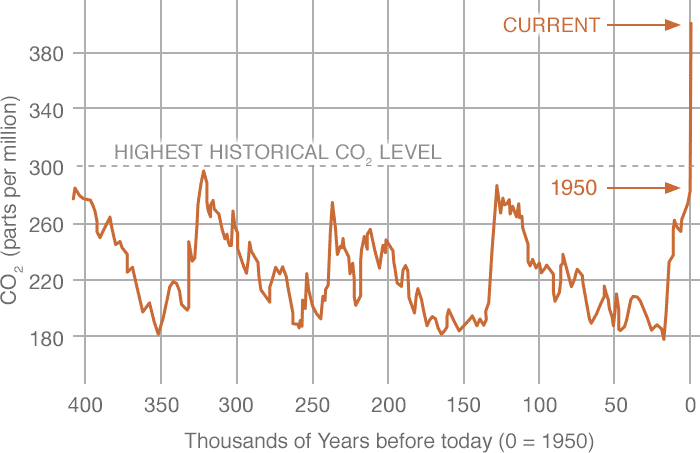
Chart: CO2 ppmv in atmosphere by year (Image Credit: NASA)
At 400+ ppmv, we are already far into uncharted territory, not only in terms of the total concentration but also in terms of the unprecedented speed at which we have increased the concentration.
For the past few decades, scientists around the world have been developing complex computational models to predict the various effects and impacts that this unprecedented increase in CO2 concentration will have on the planet. We are already observing effects from the increase in atmospheric CO2 that match what climate scientists have been predicting.
The average global temperature should already have increased by approximately 1 degree C since the late 19th century. Sure enough, by a wide variety of different ways of measuring, the global temperature has increased exactly as predicted. 16 of the 17 hottest years on record have occurred since 2001, with 2016 the very hottest.
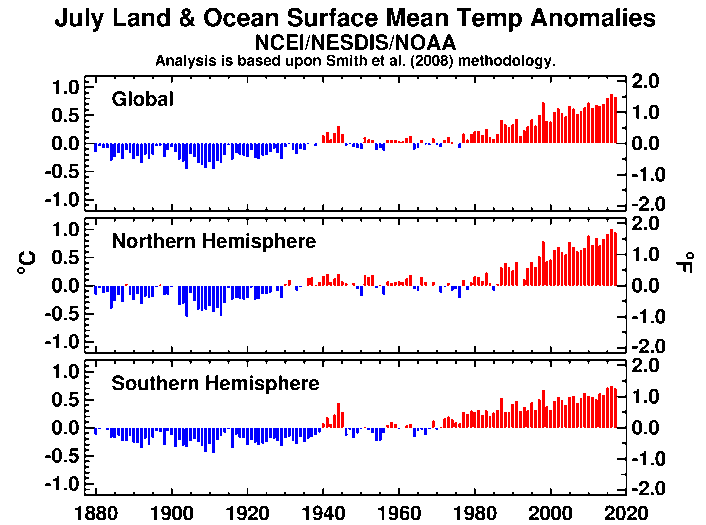
Chart: July land and ocean surface mean temperature anomalies by year, 1880-2017 (Image Credit: NOAA)
A warmer atmosphere is a more energetic atmosphere (heat is literally energy), and so there should be more extreme weather events - particularly the incidence of heat waves, droughts and torrential floods as weather systems become more erratic. Again, this is already happening.
As greenhouse gases trap more heat, the earth's oceans absorb some of the solar energy retained by our atmosphere, and thermal expansion causes sea levels to rise since water expands as it warms. In addition, melting ice sheets increase the total volume of water in the ocean, which also causes sea levels to ris. Today, sea levels are already rising as predicted.

Chart: Sea level rise by year, 1990-2017 (Image Credit: NASA)
In addition, oceans that are absorbing more carbon dioxide can expect to become more acidic. This is also already happening as predicted: oceans are already 30 percent more acidic than they were in the 19th century.
Climate scientists are very careful not to claim that a given tropical storm was "caused" by global warming. Instead, they point out that global warming creates conditions in which tropical storms are likely to be more intense, and the likelihood of extremely intense storms increases.
Tropical storms derive their energy from warm ocean water, so warmer water means more potential for higher-energy storms. In addition, warmer oceans mean more potential for water to evaporate into the atmosphere, resulting in storms with heavier rainfall.
More energetic storms with more water vapor mean more intense storm surges and higher precipitation. At the same time, a higher sea level means the more intense storm surges are also starting from a higher baseline.
The data remains unclear on whether the total number of tropical storms will change as a result of global warming, but the average intensity of those storms can be expected to continue increasing - with the risk of any given storm reaching Category 5 intensity also going up.
So when two extremely intense tropical storms occur in close succession in a global context that is already being changed by warming, it would irresponsibly "politicize" the discussion not to mention that fact.
A warmer atmosphere will cause snow and ice cover around the poles to decrease as more snow melts, and this is already happening, especially around the north pole. In fact, it's happening faster than the conservative predictions and we have already experienced summers in which arctic ice has disappeared entirely. Since ice reflects heat, the loss of ice cover also acts to accelerate warming.
As snow cover disappears and the ground heats up, the permafrost starts to unfreeze. This, in turn, produces a positive feedback loop because the thawing arctic tundra starts releasing methane gas that has been sequestered in the permafrost. Since methane is also a greenhouse gas, permafrost melt actually accelerates atmospheric warming by increasing the amount of free methane.
This is already happening, and in fact is happening faster than the conservative predictions.
Warming is expected to cause glaciers to retreat and shrink, and that is also happening globally - including on Antarctica, which is already losing ice cover at an alarming rate. Indeed, the greening of Antarctica has already begun.
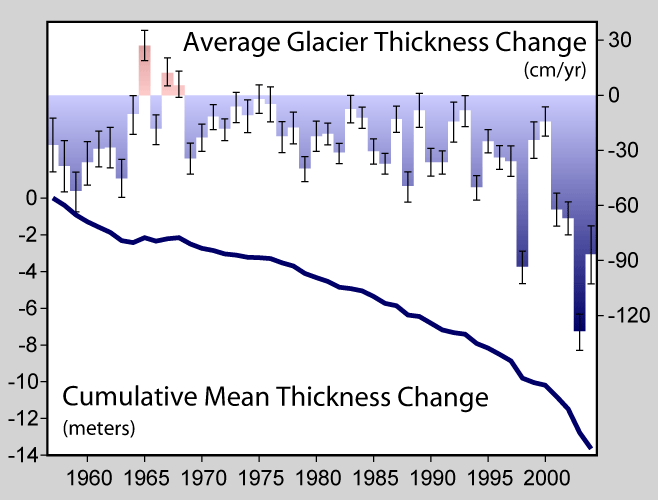
Chart: Average glacier thickness change by year and cumulative mean thickness change (Image Credit: Wikipedia CC BY-SA)
Do I need to go on? We are today observing measurable effects of global warming that have been predicted by the global community of climate scientists. This is solid science, exhaustively peer-reviewed and supported by a wide array of different lines of empirical evidence from various disciplines.
Yet there are still people who believe that the science is ambiguous, or that the scientific community is divided, or even that there is some kind of evil conspiracy on the part of scientists to dupe the public into believing that global warming is happening.
There is, in fact, a well-funded disinformation campaign going on, but it is not being carried out by the scientific community. Rather, there has been an active campaign, funded by financial interests that benefit from the status quo, to sow fear, uncertainty and doubt (FUD) about global warming.
The science is far too well-supported by the evidence to be disproved, but a constellation of libertarian ideologues, unscrupulous lobbyists and fossil fuel industry shills have been remarkably successful in producing enough confusion and uncertainty to paralyze any meaningful policy action on reducing greenhouse gas emissions.
This FUD campaign has followed the same playbook that the tobacco industry used to confuse, stall and delay the inevitable regulation of cigarettes. It is even being carried out by many of the same organizations and people the tobacco industry used, in what science historians Naomi Oreskies and Erik Conway call "a decades-old pattern of attempts to deny the reality of environmental ills - smoking, acid rain, ozone depletion, and global warming."
As they wrote in 2010: "In the case of global warming, there is strong evidence that this contrarian campaign is enjoying success, with recent polls showing that more than half of Americans are not particularly worried about the issue and that fully 40 percent believe there is major disagreement among scientists about whether climate change is even occurring. This confusion is no doubt due, at least in part, to the persistent campaigns of obfuscation by the Competitive Enterprise Institute and other global warming deniers who use right-wing talk radio, the Internet, and television programs such as Fox News to propagate their message of doubt."
This is, of course, the parallel right-wing media universe that has created and sustained an ideological framework in which straight falsehoods have been given the opportunity to flourish.
The so-called Merchants of Doubt have been remarkably successful. Here we are in 2017 and the President of the United States of America is an avowed denier who actually seems to believe global warming is a Chinese hoax to weaken the USA. He recently withdrew the United States from the Paris Agreement, the first global treaty that actually commits signatories to the goal of limiting global warming (to 2 degrees Celsius).
The President's head of the U.S. Environment Protection Agency (EPA) also denies the scientific consensus on global warming and made his political career before his appointment by repeatedly suing the EPA for "activism" when he was the Attorney General of Oklahoma.
The President's Secretary of State is the former CEO of oil giant ExxonMobil, one of the world's largest corporations, which internally acknowledged global warming as early as the 1970s but spent the past 30 years actively funding global warming denial efforts.
And while Canada has a Prime Minister who makes encouraging noises about global warming and is implementing a modest carbon tax, the Canadian Federal Government subsidizes the oil industry to the tune of over $3 billion a year and keeps approving new oil pipelines.
After criticizing the previous government's weak targets for reducing greenhouse gas emissions, the current government went on to adopt those same weak targets and has backpedalled furiously from the idea of phasing out the Alberta oilsands.
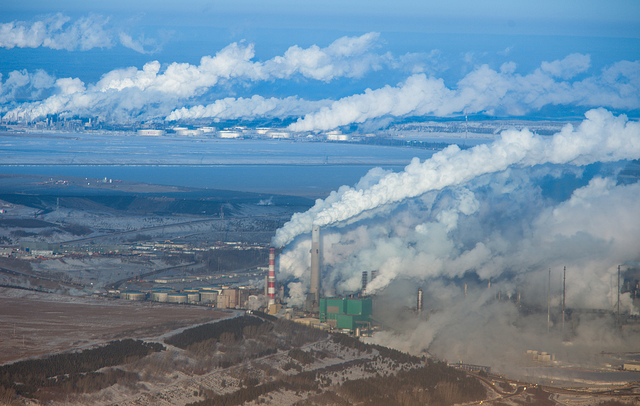
Alberta Oilsands, Fort McMurray (Image Credit: Kris Krüg/Flickr. CC BY-NC-SA 2.0)
In other words, the stalling and hand-wringing continues today, even from governments that claim to take global warming seriously. I shudder to consider what future generations will think of us.
By NortheastWind (registered) | Posted September 08, 2017 at 14:22:11
Tropical storms were intense in the early 1920's, then in the 30's, then in the 50's and 60's, then 90's. It's cyclical. Strange thing, even though the Pacific Ocean is warmer than average, there is not one tropical storm right now, which is very unusual for this time of year. Search Twitter for ACE (Accumulated Cyclone Energy) Index, which shows no upward trend in intensity over the past 160 years, just an up and down cycle over the years. Some years are bad, some not. Again, it's cyclical.
Comment edited by NortheastWind on 2017-09-08 14:22:47
By KevinLove (registered) | Posted September 13, 2017 at 08:51:13 in reply to Comment 121930
The South Pacific Cyclone Season begins on November 1, 2017. A fact that took me about 8 seconds on Google to find.
Which, of course, proves Ryan's point about deniers in this particular case.
Comment edited by KevinLove on 2017-09-13 08:51:25
By ergopepsi (registered) | Posted September 13, 2017 at 09:46:37 in reply to Comment 121945
At this point I think people who have decided to be climate change deniers will not change their positions regardless of the data that is put in front of them.
The biggest problem with communicating this issue is the widely adopted perception that there are 'two sides to this story'. Bill Nye 'The Science Guy' once lamented that media outlets are supporting this idea by having discussion panels with one scientist accepting the data and one denying it. This promotes the idea that there is actually an argument in the scientific community when there is none. He said the panels should be about four thousand scientists supporting the data and one not. This would be a more accurate display of how the data is read by actual scientists.
Regardless of all this, policymakers and business leaders are listening to reason and action is taking place. Trump pulling out of the Paris accord was a political stunt with no teeth whatsoever. The US business community is taking the lead in reducing carbon consumption. https://www.nytimes.com/2017/04/25/clima...
And China (recall they 'invented' climate change to hurt the US) https://www.bloomberg.com/news/articles/...
And on and on: http://www.cbc.ca/news/business/volvo-hy... http://www.greencarreports.com/news/1104... https://www.theguardian.com/environment/...
By kevlahan (registered) | Posted September 08, 2017 at 15:38:37 in reply to Comment 121930
The evidence is mixed, but the scientific consensus right now is that overall the evidence is still too weak to confidently claim that the intensity or number of tropical storms has increased due human caused warning, although some papers claim to have detected a link.
This could be because the effect of a warming climate is still too small, or because the historical record is not good enough (changes in observation methods, accuracy, definitions etc.) For example, the evidence is fairly strong for an increase in intense category 4-5 storms since the 1940s, but it is not clear that the historical data is good enough to make a convincing claim.
However, there is strong consensus that increased warming will produce more intense storms with more rainfall by the end of the century. The likelihood of very intense storms will also increase. The basic physics means that warmer atmospheres and warmer oceans will eventually lead to more intense storms and rainfall.
https://www.gfdl.noaa.gov/global-warming...
A recent paper in Nature Climate Change did find a slight increase in the intensity of tropical storms over the last 30 years, but with fewer tropical storms overall.
http://www.nature.com/nclimate/journal/v...
There is no evidence to suggest that the incidence of tropical storms is "cyclical", unless by cyclical you simply means that it naturally fluctuates over time (not that it is periodic).
Comment edited by kevlahan on 2017-09-08 16:18:42
By Jim111 (registered) | Posted September 10, 2017 at 05:01:31
I thought it was the Mexicans, Gays and Abortionists that created all this angry weather. Ask God.
You must be logged in to comment.
There are no upcoming events right now.
Why not post one?